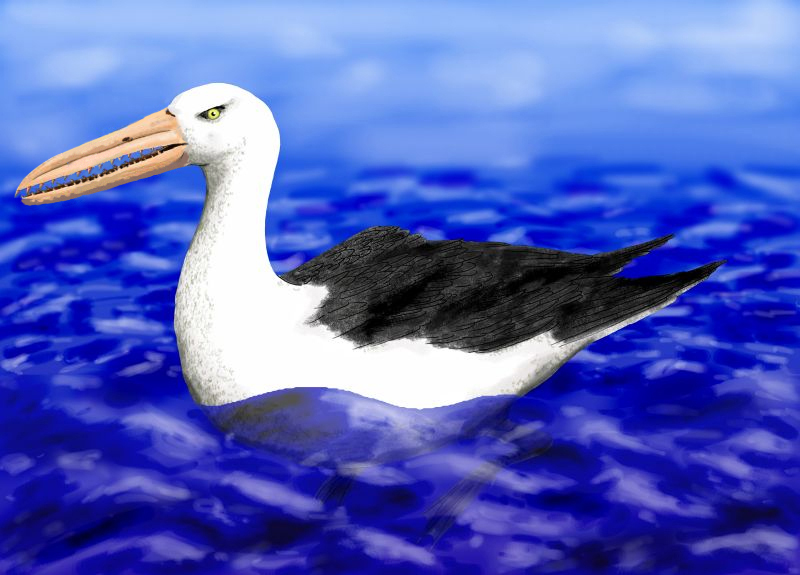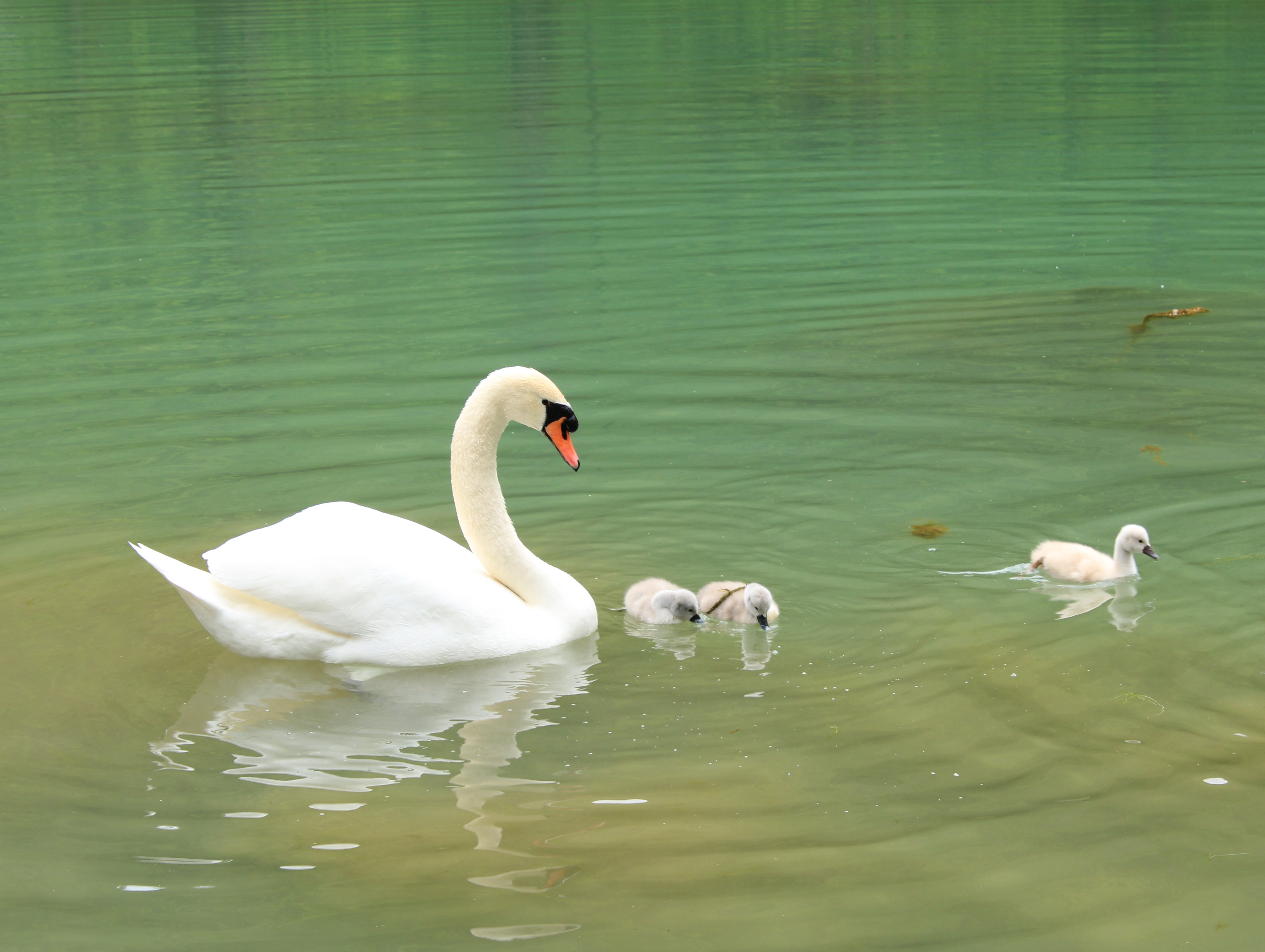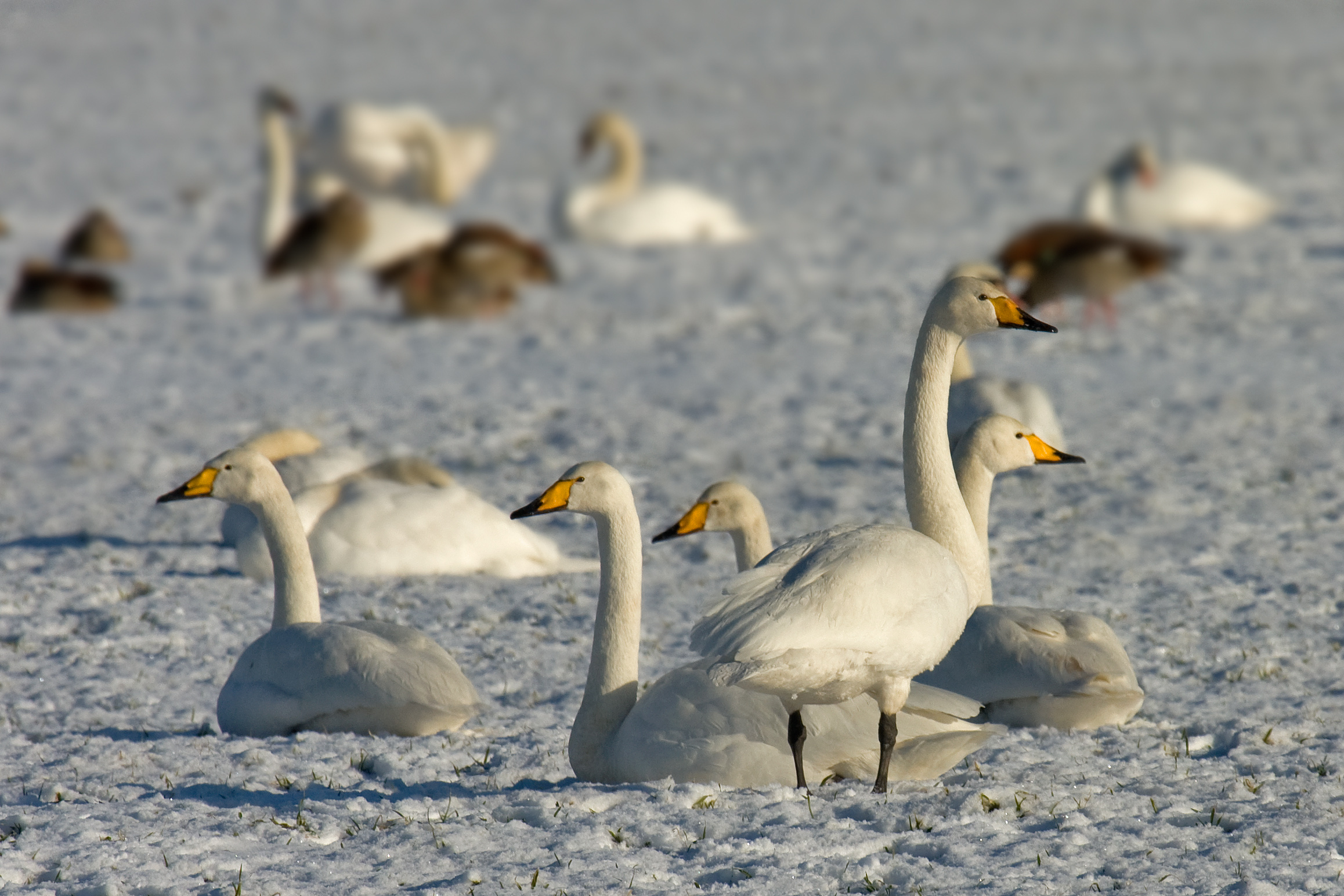|
Anserinae
The Anserinae are a subfamily in the waterfowl family Anatidae. It includes the swans and the true Goose, geese. Under alternative systematics, systematical concepts (see e.g., Terres & NAS, 1991), it is split into two subfamilies, the Anserinae contain the geese and the ducks, while the Cygninae contain the swans. Systematics Swans (Tribe Cygnini) *Genus ''Cygnus (genus), Cygnus'' – true swans: The black-and-yellow-billed swans are sometimes separated in the genus ''Olor''. *Genus †''Afrocygnus'' (Miocene of North Africa) *Genus †''Annakacygna –'' short-winged swans (Miocene of Japan) *Genus †''Megalodytes'' (Miocene of California) True geese (Tribe Anserini) *Genus ''Anser (genus), Anser'' – grey and white geese *Genus ''Branta'' – black geese (including †''Branta rhuax, B. rhuax'', formerly placed in ''Geochen'') Unresolved *Genus ''Coscoroba'' – coscoroba swan These two genera are distinct from other geese and often elevated to a subfamily of their own ... [...More Info...] [...Related Items...] OR: [Wikipedia] [Google] [Baidu] |
Anatidae
The Anatidae are the biological family (biology), family of water birds that includes ducks, goose, geese, and swans. The family has a cosmopolitan distribution, occurring on all the world's continents except Antarctica. These birds are adapted for aquatic locomotion, swimming, floating on the water surface, and, in some cases, diving in at least shallow water. The family contains around 174 species in 43 genus, genera (the magpie goose is no longer considered to be part of the Anatidae and is now placed in its own family, Anseranatidae). They are generally herbivorous and are monogamy in animals, monogamous breeders. A number of species undertake bird migration, annual migrations. A few species have been domesticated for agriculture, and many others are hunted for food and recreation. Five species have become extinct since 1600, and many more are threatened with extinction. Description and ecology The ducks, geese, and swans are small- to large-sized birds with a broad and elo ... [...More Info...] [...Related Items...] OR: [Wikipedia] [Google] [Baidu] |
Waterfowl
Anseriformes is an order of birds also known as waterfowl that comprises about 180 living species of birds in three families: Anhimidae (three species of screamers), Anseranatidae (the magpie goose), and Anatidae, the largest family, which includes over 170 species of waterfowl, among them the ducks, geese, and swans. Most modern species in the order are highly adapted for an aquatic existence at the water surface. With the exception of screamers, males have penises, a trait that has been lost in the Neoaves, the clade consisting of all other modern birds except the galliformes and paleognaths. Due to their aquatic nature, most species are web-footed. Evolution Anseriformes are one of only two types of modern bird to be confirmed present during the Mesozoic alongside the other dinosaurs, and in fact were among the very few birds to survive their extinction, along with their cousins, the Galliformes. These two groups only occupied two ecological niches during the Mesozoic, ... [...More Info...] [...Related Items...] OR: [Wikipedia] [Google] [Baidu] |
Cereopsis
The Cape Barren goose (''Cereopsis novaehollandiae''), sometimes also known as the pig goose, is a species of goose endemic to southern Australia. It is a distinctive large, grey bird that is mostly terrestrial and is not closely related to other extant members of the subfamily Anserinae. Taxonomy and history The indigenous Jardwadjali people of western Victoria refer to this species as ''toolka''. The Noongar / Nyungar people of south-western Western Australia use the name ''bibib.'' The Cape Barren goose was first formally described by English ornithologist John Latham in 1801 as ''Cereopsis N. Hollandiae''. The species had been earlier reported from the Bass Strait by George Bass and Matthew Flinders in 1798, who referred to it as a " Brent or Barnacle Goose". The taxonomic placement of this species is not yet fully resolved. It is now generally recognised as being a member of the subfamily Anserinae, however, it has also been associated with Tadorninae. When placed with ... [...More Info...] [...Related Items...] OR: [Wikipedia] [Google] [Baidu] |
Swan
Swans are birds of the genus ''Cygnus'' within the family Anatidae. The swans' closest relatives include the goose, geese and ducks. Swans are grouped with the closely related geese in the subfamily Anserinae where they form the tribe (biology), tribe Cygnini. Sometimes, they are considered a distinct subfamily, Cygninae. They are the largest Anseriformes, waterfowl and are often among the largest Bird flight, flighted birds in their range. There are six living and many extinct species of swan; in addition, there is a species known as the coscoroba swan which is no longer considered one of the true swans. Swans usually mate for life, although separation sometimes occurs, particularly following nesting failure, and if a mate dies, the remaining swan will take up with another. The number of bird egg, eggs in each :wikt:clutch, clutch ranges from three to eight. Taxonomy and terminology The genus ''Cygnus'' was introduced in 1764 by the French naturalist François Alexandre Pier ... [...More Info...] [...Related Items...] OR: [Wikipedia] [Google] [Baidu] |
Cygnini
Swans are birds of the genus ''Cygnus'' within the family Anatidae. The swans' closest relatives include the geese and ducks. Swans are grouped with the closely related geese in the subfamily Anserinae where they form the tribe Cygnini. Sometimes, they are considered a distinct subfamily, Cygninae. They are the largest waterfowl and are often among the largest flighted birds in their range. There are six living and many extinct species of swan; in addition, there is a species known as the coscoroba swan which is no longer considered one of the true swans. Swans usually mate for life, although separation sometimes occurs, particularly following nesting failure, and if a mate dies, the remaining swan will take up with another. The number of eggs in each clutch ranges from three to eight. Taxonomy and terminology The genus ''Cygnus'' was introduced in 1764 by the French naturalist François Alexandre Pierre de Garsault. The English word ''swan'', akin to the German , Dutch a ... [...More Info...] [...Related Items...] OR: [Wikipedia] [Google] [Baidu] |
Coscoroba
The coscoroba swan (''Coscoroba coscoroba'') is a species of waterfowl in the subfamily Anserinae of the family Anatidae.HBW and BirdLife International (2021) Handbook of the Birds of the World and BirdLife International digital checklist of the birds of the world. Version 6. Available at: http://datazone.birdlife.org/userfiles/file/Species/Taxonomy/HBW-BirdLife_Checklist_v6_Dec21.zip retrieved August 7, 2022 It is found in Argentina, Bolivia, Brazil, Chile, Paraguay, Uruguay, and the Falkland Islands.Remsen, J. V., Jr., J. I. Areta, E. Bonaccorso, S. Claramunt, A. Jaramillo, D. F. Lane, J. F. Pacheco, M. B. Robbins, F. G. Stiles, and K. J. Zimmer. Version 24 July 2022. Species Lists of Birds for South American Countries and Territories. https://www.museum.lsu.edu/~Remsen/SACCCountryLists.htm retrieved July 24, 2022 Taxonomy and systematics The coscoroba swan's placement within the family Anatidae is not fully agreed upon, with a 2014 genetic study positing a phylogenetic relati ... [...More Info...] [...Related Items...] OR: [Wikipedia] [Google] [Baidu] |
Swan
Swans are birds of the genus ''Cygnus'' within the family Anatidae. The swans' closest relatives include the goose, geese and ducks. Swans are grouped with the closely related geese in the subfamily Anserinae where they form the tribe (biology), tribe Cygnini. Sometimes, they are considered a distinct subfamily, Cygninae. They are the largest Anseriformes, waterfowl and are often among the largest Bird flight, flighted birds in their range. There are six living and many extinct species of swan; in addition, there is a species known as the coscoroba swan which is no longer considered one of the true swans. Swans usually mate for life, although separation sometimes occurs, particularly following nesting failure, and if a mate dies, the remaining swan will take up with another. The number of bird egg, eggs in each :wikt:clutch, clutch ranges from three to eight. Taxonomy and terminology The genus ''Cygnus'' was introduced in 1764 by the French naturalist François Alexandre Pier ... [...More Info...] [...Related Items...] OR: [Wikipedia] [Google] [Baidu] |
Goose
A goose (: geese) is a bird of any of several waterfowl species in the family Anatidae. This group comprises the genera '' Anser'' (grey geese and white geese) and '' Branta'' (black geese). Some members of the Tadorninae subfamily (e.g., Egyptian goose, Orinoco goose) are commonly called geese, but are not considered "true geese" taxonomically. More distantly related members of the family Anatidae are swans, most of which are larger than true geese, and ducks, which are smaller. The term "goose" may refer to such bird of either sex, but when paired with "gander", "goose" refers specifically to a female one ("gander" referring to a male). Young birds before fledging are called goslings. The collective noun for a group of geese on the ground is a gaggle; when in flight, they are called a skein, a team, or a wedge; when flying close together, they are called a plump. Etymology The word "goose" is a direct descendant of Proto-Indo-European ''*ǵʰh₂éns''. In Germanic lang ... [...More Info...] [...Related Items...] OR: [Wikipedia] [Google] [Baidu] |
Shelduck
The shelducks, most species of which are found in the genus ''Tadorna'' (except for the Radjah shelduck, which is now found in its own monotypic genus ''Radjah''), are a group of large birds in the Tadorninae subfamily of the Anatidae, the biological family that includes the ducks and most duck-like waterfowl such as the geese and swans. Biology Shelducks are a group of large, often semi-terrestrial waterfowl, which can be seen as intermediate between geese (''Anserinae'') and ducks. They are mid-sized (some 50–60 cm) Old World waterfowl. The sexes are colored slightly differently in most species, and all have a characteristic upperwing coloration in flight: the tertiary remiges form a green speculum, the secondaries and primaries are black, and the coverts (forewing) are white. Their diet consists of small shore animals ( winkles, crabs etc.) as well as grasses and other plants. They were originally known as "sheldrakes", which remained the most common name until the lat ... [...More Info...] [...Related Items...] OR: [Wikipedia] [Google] [Baidu] |
New Zealand Geese
The New Zealand goose is a bird of the extinct genus ''Cnemiornis'' of the family Anatidae, subfamily Anserinae. The genus, endemic to New Zealand, consisted of two species: the North Island goose, ''C. gracilis'' and the South Island goose ''C. calcitrans''. Description This goose was as large as some small moa. The North Island species had in body mass while the South Island species reached , far surpassing Canada and Cape barren geese. They were flightless, with much-reduced webbing on the feet, an adaptation for terrestrial dwelling similar to that of the nene of Hawaii. They are usually considered most closely related to the Cape Barren goose of Australia. Extinction They were never particularly common, and like many other large New Zealand endemic species they were subject to hunting pressures from the settling Polynesians, as well as predation upon their eggs and hatchlings by kiore, or the Polynesian rat (which accompanied the settlers) and the settlers' dogs, ... [...More Info...] [...Related Items...] OR: [Wikipedia] [Google] [Baidu] |
Branta
The black geese of the genus ''Branta'' are waterfowl belonging to the Goose, true geese and swans subfamily Anserinae. They occur in the northern coastal regions of the Palearctic and all over North America, Bird migration, migrating to more southerly coasts in winter, and as resident birds in the Hawaiian Islands. Alone in the Southern Hemisphere, a self-sustaining Feral animal, feral population derived from introduced Canada geese is also found in New Zealand. The black geese derive their vernacular name for the prominent areas of black coloration found in all species. They can be distinguished from all other true geese by their legs and feet, which are black or very dark grey. Furthermore, they have black bills and large areas of black on the head and neck, with white (ochre in one species) markings that can be used to tell apart most species.The nēnē, which is aberrant in many respects, has no white on the head or neck and fairly little black, being quite similar to the s ... [...More Info...] [...Related Items...] OR: [Wikipedia] [Google] [Baidu] |
Late Quaternary Prehistoric Birds
Late Quaternary prehistoric birds are Bird, avian taxa that became extinct during the Late Quaternary – the Late Pleistocene or Early Holocene – and before recorded history, specifically before they could be studied alive by ornithological science. They had died out before the period of global scientific exploration that started in the late 15th century. In other words, this list deals with avian extinctions between Upper Paleolithic, 40,000 BC and AD 1500. For the purposes of this article, a "bird" is any member of the clade Neornithes, that is, any descendant of the most recent common ancestor of all currently living birds. The birds are known from their remains, which are subfossil; as the remains are not completely fossilized, they may yield organic material for molecular analyses to provide additional clues for resolving their Taxonomy (biology), taxonomic affiliations. Some birds are also known from folk memory, as in the case of Haast's eagle in New Zeala ... [...More Info...] [...Related Items...] OR: [Wikipedia] [Google] [Baidu] |








